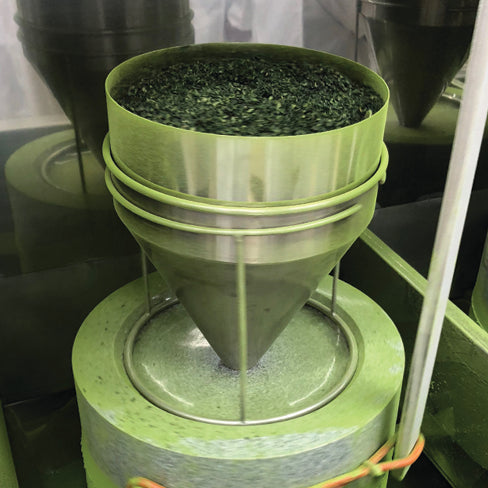Green tea plants known as Camellia Sinensis are shaded in darkness for 25-30 days before harvest.
Shading methods vary from farmer to farmer, but the intention remains the same: to protect delicate tea leaves from frostbite and to boost nutrient production by suppressing photosynthesis which prevents amino acids in the tea leaves to convert into catechins (the antioxidant known to impart bitter qualities). Inhibiting sunlight during this period results in producing thinner, more delicate tea leaves which are often more darker and deeper in color.

In the spring and summer, leaves are selectively picked depending on grade.
The two seasons matcha is primarily harvested in is during Ichibancha (literally meaning “first tea” or first harvest season from late April to May) and Nibancha (meaning “second tea” and refers to the second harvest of the year taking place from June to the end of July).

Immediate steaming & drying after harvest preserve flavor and nutrients.
Mushi (or to steam) tea leaves is a necessary step and method of fixing which halts oxidation during processing. Once the tea leaves are steamed, they are rolled and dried (known as Aracha or crude tea). Aracha is made up of unrefined, semi-processed tea leaves that require further processing in order to be made into matcha.

Leaves are de-stemmed and de-veined to improve texture and taste.
The tea leaves undergo further processing as the stems and veins are removed to become Tencha (ten meaning “grind”). This sorting process is usually done using pressurized air because the veins and stems are heavier than other leaf particles. Tencha is made up of tiny pieces of flaky leaf bits.

Very much like wine, tencha is aged gracefully.
Kuradashi (literally meaning bring out of cellar) is an important step in crafting divine matcha. Tencha can be aged for several months (and even sometimes years) before it is ground into matcha.
Stone grinding slowly and gently pulverizes leaves into a fine powder.
Matcha (or ground tea) is made by stone grinding tencha in a large granite mill called ish-iusu.

The finished matcha is packaged into specialized tins or pouches to maintain freshness.

